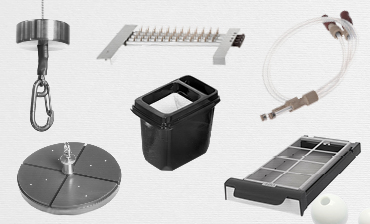Evaporative light-scattering detection (ELSD) is an effective tool for detecting compounds with minimal to no UV absorbance. ELS detectors convert the column effluent into an aerosol by adding heated nitrogen. Prior to aerosol formation, the column effluent is diluted with a volatile make-up solvent. However, the choice of make-up solvent can impact ELS sensitivity.
For this experiment, I purified a mixture of five compounds on a silica column with a heptane and ethyl acetate (EtOAc) gradient. During purification, I employed both UV and ELSD detection methods, each with a different make-up solvent. For make-up solvents I used acetone, acetonitrile, and methanol, all at an evaporation temperature of 36 °C, Figure 1.

Figure 1. ELSD make-up solvent choice impacted detection sensitivity with acetone providing the greatest response followed by equal responses from acetonitrile and methanol.
From this data we can see that acetone provided the best ELSD signal, but acetonitrile and methanol are suitable replacements, if you have a concern about the eluting compounds’ solubility in acetone.
The differences in signal intensity are not boiling point-based. In fact, acetonitrile has a much higher BP (82 °C) than acetone (56 °C) or methanol (64.7 °C), but its ELSD responses exceed those of methanol. Each solvent has a density of ~0.79 g/mL, so that is not a factor either. What may be driving the sensitivity differences are make-up solvent–solute interactions.
I also compared the same three make-up solvents for the reversed-phase purification of a hemp extract and saw more of a difference between them (Fig 2).

Figure 2. Effect of ELSD make-up solvent on reversed phase detection sensitivity showed acetone provided the greatest response followed by acetonitrile and then methanol.
With reversed phase we see again that acetone is best, followed by acetonitrile and then methanol. I believe the sensitivity differences in reversed-phase may be H-bond related (MeOH with the mobile phase’s water).
The bottom line is that when using an ELSD with your flash system, acetone is likely to be the best make-up solvent, although acetonitrile and methanol are suitable options too.
Equipment used for this post include:
- Biotage® Selekt
- Biotage® Selekt ELSD
- Biotage® Sfär HC column, 10 g
- Biotage® Sfär C18 column, 6 g

 Organic Workflow
Organic Workflow Peptide Workflow
Peptide Workflow Scale-Up Flash Purification
Scale-Up Flash Purification  Sample Preparation
Sample Preparation Biomolecule Purification
Biomolecule Purification Oligo synthesis
Oligo synthesis Scavengers and Reagents
Scavengers and Reagents Service & Support
Service & Support Accessories & Spare parts
Accessories & Spare parts Investors
Investors Reports & News
Reports & News The Share
The Share Corporate Governance
Corporate Governance Calendar
Calendar Sustainability
Sustainability Our Offering
Our Offering Our History
Our History Our Locations
Our Locations Leadership
Leadership
